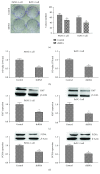MCOLN1 Promotes Proliferation and Predicts Poor Survival of Patients with Pancreatic Ductal Adenocarcinoma
- PMID: 31481985
- PMCID: PMC6701426
- DOI: 10.1155/2019/9436047
MCOLN1 Promotes Proliferation and Predicts Poor Survival of Patients with Pancreatic Ductal Adenocarcinoma
Retraction in
-
RETRACTION: MCOLN1 Promotes Proliferation and Predicts Poor Survival of Patients with Pancreatic Ductal Adenocarcinoma.Dis Markers. 2025 May 6;2025:9850902. doi: 10.1155/dim/9850902. eCollection 2025. Dis Markers. 2025. PMID: 40435332 Free PMC article.
Abstract
Background: MCOLN1 (mucolipin subfamily, member 1) was first identified as an autophagic regulator, which was essential for efficient fusion of both autophagosomes and late endosomes with lysosomes. This study is aimed at investigating the role of MCOLN1 in the development of pancreatic ductal adenocarcinoma (PDAC).
Methods: Immunohistochemistry (IHC) assay was conducted to evaluate the expression level of MCOLN1 in 82 human PDAC tumor tissues. Overall survival (OS) and recurrence-free survival (RFS) analysis was performed to assess the prognosis of patients. Colony formation and MTT assays [3-(4,5-dimethyl-2-thiazolyl)-2,5-diphenyl-2-H-tetrazolium bromide] were performed to measure the proliferation capacity of tumor cells. The expression level of related genes was measured by RT-PCR (reverse transcription polymerase chain reaction) and western blot assays. The animal model was used to examine the effects of indicated protein on tumorigenesis in vivo.
Results: The results of IHC showed that a high level of MCOLN1 expression was associated with the poor clinical characteristics of PDAC patients. OS and RFS were significantly worse in patients with high MCOLN1 expression. Silencing of MCOLN1 dramatically blocked the proliferation of PDAC cells. Mechanism studies confirmed that knockdown of MCOLN1 decreased the expression of Ki67 and PCNA (proliferating cell nuclear antigen), two markers of cell proliferation. In vivo, MCOILN1 depletion reduced the formation and growth of tumors in mice.
Conclusion: The high level of MCOLN1 expression was associated with poor clinical outcomes of PDAC patients. MCOLN1 ablation could inhibit PDAC proliferation of both in vitro and in vivo, which provide a new insight and novel therapeutic target for the treatment of PDAC.
Conflict of interest statement
The authors have declared that no competing financial interest exists.
Figures




Similar articles
-
Knockdown of FOXO3a induces epithelial-mesenchymal transition and promotes metastasis of pancreatic ductal adenocarcinoma by activation of the β-catenin/TCF4 pathway through SPRY2.J Exp Clin Cancer Res. 2019 Jan 28;38(1):38. doi: 10.1186/s13046-019-1046-x. J Exp Clin Cancer Res. 2019. Retraction in: J Exp Clin Cancer Res. 2022 Jun 17;41(1):204. doi: 10.1186/s13046-022-02413-2. PMID: 30691517 Free PMC article. Retracted.
-
S100A14 promotes progression and gemcitabine resistance in pancreatic cancer.Pancreatology. 2021 Apr;21(3):589-598. doi: 10.1016/j.pan.2021.01.011. Epub 2021 Jan 22. Pancreatology. 2021. PMID: 33579599
-
A potential prognostic marker and therapeutic target: SPOCK1 promotes the proliferation, metastasis, and apoptosis of pancreatic ductal adenocarcinoma cells.J Cell Biochem. 2020 Jan;121(1):743-754. doi: 10.1002/jcb.29320. Epub 2019 Sep 3. J Cell Biochem. 2020. PMID: 31478239
-
CREPT serves as a biomarker of poor survival in pancreatic ductal adenocarcinoma.Cell Oncol (Dordr). 2021 Apr;44(2):345-355. doi: 10.1007/s13402-020-00569-7. Epub 2020 Oct 30. Cell Oncol (Dordr). 2021. PMID: 33125631
-
KIF4A Regulates the Progression of Pancreatic Ductal Adenocarcinoma through Proliferation and Invasion.Biomed Res Int. 2021 Nov 11;2021:8249293. doi: 10.1155/2021/8249293. eCollection 2021. Biomed Res Int. 2021. Retraction in: Biomed Res Int. 2025 Apr 29;2025:9759616. doi: 10.1155/bmri/9759616. PMID: 34805404 Free PMC article. Retracted.
Cited by
-
Metabolomic Approach to Identify Potential Biomarkers in KRAS-Mutant Pancreatic Cancer Cells.Biomedicines. 2024 Apr 15;12(4):865. doi: 10.3390/biomedicines12040865. Biomedicines. 2024. PMID: 38672219 Free PMC article.
-
Lysosomes in Cancer-At the Crossroad of Good and Evil.Cells. 2024 Mar 5;13(5):459. doi: 10.3390/cells13050459. Cells. 2024. PMID: 38474423 Free PMC article. Review.
-
Coexpression of TRPML1 and TRPML2 Mucolipin Channels Affects the Survival of Glioblastoma Patients.Int J Mol Sci. 2022 Jul 13;23(14):7741. doi: 10.3390/ijms23147741. Int J Mol Sci. 2022. PMID: 35887088 Free PMC article.
-
INPP4B promotes PDAC aggressiveness via PIKfyve and TRPML-1-mediated lysosomal exocytosis.J Cell Biol. 2024 Nov 4;223(11):e202401012. doi: 10.1083/jcb.202401012. Epub 2024 Aug 9. J Cell Biol. 2024. PMID: 39120584 Free PMC article.
-
RETRACTION: Kinesin Family Member 18A (KIF18A) Contributes to the Proliferation, Migration, and Invasion of Lung Adenocarcinoma Cells In Vitro and In Vivo.Dis Markers. 2025 May 7;2025:9808595. doi: 10.1155/dim/9808595. eCollection 2025. Dis Markers. 2025. PMID: 40371195 Free PMC article.
References
-
- Rahib L., Smith B. D., Aizenberg R., Rosenzweig A. B., Fleshman J. M., Matrisian L. M. Projecting cancer incidence and deaths to 2030: the unexpected burden of thyroid, liver, and pancreas cancers in the United States. Cancer Research. 2014;74(11):2913–2921. doi: 10.1158/0008-5472.CAN-14-0155. - DOI - PubMed
Publication types
MeSH terms
Substances
LinkOut - more resources
Full Text Sources
Other Literature Sources
Medical
Miscellaneous

